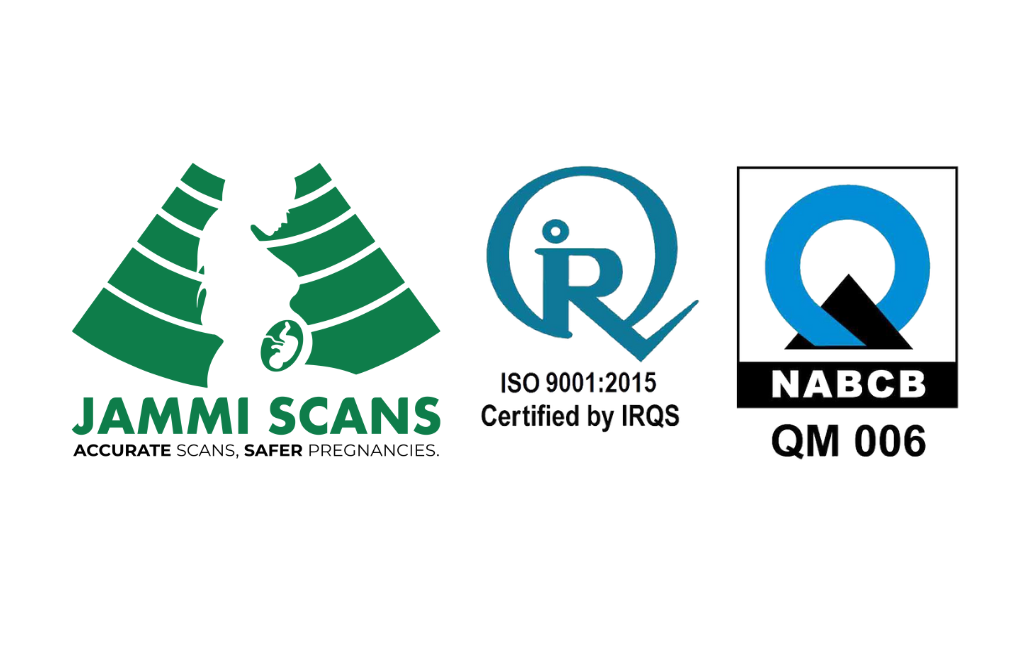Multiple Pregnancy Scans for Twins & Triplets (T. Nagar, Chennai)
Book a Scan for Twins / Triplets with Dr. Deepthi Jammi Today
🕘 Choose your convenient time slot between: 8.30 AM - 6 PM
📍 Visit us: No. 14, Jagadeeswaran St, T. Nagar, Chennai, Tamil Nadu 600017
What Is Multiple Pregnancy?
A multiple pregnancy is when a woman carries a twin, triplet, or more babies in her womb. More than three babies are termed a higher-order pregnancy.

Multiple Pregnancies Scan at Jammi Scans
Multiple Pregnancies Scans
Worried about your multiple pregnancies scan results. Get a second opinion from the best fetal medicine specialist in Chennai, Dr. Deepthi Jammi
Experience
With over 15 years of experience, Dr. Deepthi Jammi has performed over 1,50,000 successful scans.
Same Day Report
We understand your nervousness after a scan, so we provide same-day reports to ease your mind and save your time.
Book Appointment
Contact Jammi scans at 7338771733 for appointments to visit our scan centre
Latest Technology
We use the latest, high-quality ultrasound technology for our scans.
What Are Some Causes Of Multiple Pregnancy?
Fertility treatment: If you are undergoing fertility treatments including IVF and ICSI, there are high chances for you to conceive multiple babies such as twins, triplets.
Getting pregnant after late 30’s: If you are getting pregnant in your late 30’s or later, you tend to release more than one egg leading to increased chances of multiple babies.
Family history: If you are a twin yourself, or have a sibling who is a twin or other family history of twins or triplets, you have higher chances of conceiving multiple babies.
Obesity: Researchers say that obese women have higher chances of conceiving twins.
Difference Between Identical And Non-Identical Twins
Identical babies are called monozygotic:
Monozygotic siblings come from one egg. In this case the egg has been fertilised by one sperm and then split into two or more embryos. These babies will all be the same sex. They will all have identical genes.
Non-identical twins are called dizygotic
Triplets or higher multiples are polyzygotic. In this case each egg is fertilised by a separate sperm. The babies are not necessarily the same gender and they have different genes.
Is The Risk Of Complications Higher With Multiple Pregnancy?
- There is an increased risk of stillbirth.
- There is an increased risk of preterm birth.
- Twin-twin transfusion syndrome (TTTS) occurs commonly in monochorionic twins. But it also occurs in monochorionic and dichorionic triplets.
- There is an increased risk of umbilical cord entanglement, mainly in monochorionic monoamniotic twin pregnancies.
- There is an increased risk of IUGR.
- There is an increased risk of congenital abnormalities.
Type Of Scans Done In Multiple Pregnancies
The extra scans that can be performed for multiple pregnancies are:
- A chorionicity scan at the same time as the dating scan and combined screening test. This is to check whether the babies share a placenta, or have one each.
- Growth scans in the third trimester will check that the babies are growing normally. Babies sharing a placenta will be scanned every two weeks from 16 weeks. Those with their own placenta will be scanned every four weeks from 20 weeks.
Scanning twins is more of a challenge than scanning one baby, because one twin is often behind the other.
If one baby’s head is low in the pelvis, it would be difficult to get any measurements. The scans will take more time than they would for a single pregnancy.
It may not be easy to check the babies’ growth, and scans will not tell exactly how big the babies are. But by measuring them each time during a scan it’s possible to get an idea of whether they’re growing normally.
A variety of measurements have to be taken into account to get an accurate picture of the babies. Where possible, measurements of the babies’ heads, abdomen and thigh bones will be taken.
Difference in the size of twins, whether identical or not, is expected and normal. It’s only when one twin is more than 25 per cent bigger than the other, or growing much faster, that there may be a problem.
Despite an increased number of scans, it has to be noted that there is no increased risk to the mother or the babies.
- Differences in fetal weight should be monitored using two or more parameters at each ultrasound scan from 20 weeks.
- Mothers with uncomplicated dichorionic twin pregnancies should be scanned every 4 weeks from week 20.
- Mothers with uncomplicated monochorionic diamniotic twin pregnancies should be scanned every 2 weeks from week 16.
- Monochorionic twins should be scanned fortnightly to detect TTTS from 16 to 24 weeks of gestation.
- Women with uncomplicated trichorionic triamniotic triplet pregnancies should be scanned every 4 weeks from week 20.
- Women with uncomplicated monochorionictriamniotic and dichorionictriamniotic triplet pregnancies should be scanned every 2 weeks from week 16.
- If there is a 25% or greater difference in size between twins or triplets, this is a clinically important indicator of growth restriction.
Prenatal Diagnosis
It should be noted that in a multiple pregnancy, there is a greater likelihood of Down syndrome, hence different options for screening and a higher false-positive rate of screening tests.
In case of monozygotic twins, the risk is the same for each twin. However if the babies are not monozygotic, the risk of Down’s syndrome will be different for each.
It is not possible to be as accurate in determining this risk in multiple pregnancies as it is when there is just one baby. As a result of this patients have a greater likelihood of being offered invasive testing and of complications occurring from this testing.
Screening tests for genetic disorders that use a sample of the mother’s blood are not as sensitive in multiple pregnancy.
It is possible to have a positive screening test result when no problem is present in either baby.
Invasive tests for birth defects include chorionic villus sampling and amniocentesis.
These tests are harder to perform in a multiple pregnancy because each fetus must be tested. There also is a small risk of loss of one or all of the fetuses. Screening should be performed between approximately 11 weeks 0 days and 13 weeks 6 days during which:
- The Fetal positions should be noted
- Triplet pregnancies should use nuchal translucency and maternal age. It is not advisable to use serum screening
- Mothers with uncomplicated monochorionic diamniotic twin pregnancies should be scanned every 2 weeks from week 16
If one fetus is detected as abnormal, selective termination (if desired) must be accurately targeted. Selective termination in monochorionic pregnancies could pose risks to the co-twin.
What is Twin-to-Twin Transfusion Syndrome?
Twin-to-twin transfusion syndrome (TTTS) can affect identical twins who share a placenta (monochorionic twins).
TTTS happens when there is an imbalance in the placental blood vessels that connect both twins. If the blood doesn’t flow evenly between the twins, one gets more blood, called the recipient twin, while the other gets less blood (the donor twin).
The uneven blood flow results in the recipient twin growing bigger, due to the extra nutrients and fluid than the donor twin.
The extra fluid the recipient twin takes in can put a strain on the heart. The body will try to get rid of the fluid by producing more urine. As a result, the recipient will have too much surrounding amniotic fluid, while the donor will have little or none.
The recipient twin and the extra fluid can press the donor twin against the wall of the womb (uterus). This may make the mother uncomfortable and can even result in contractions.
The vast majority of twins who share a placenta grow normally. A majority of the monochorionic twins don’t develop TTTS. TTTS can be very serious if it is not treated. However, treatment is successful in a significant percent of cases.
The scans for TTTS take place every two weeks from 16 weeks to 24 weeks. If there are signs that TTTS may be developing, the patient should have weekly scans and undergo further treatment.
The fetal medicine specialist can offer multiple options. One is to drain amniotic fluid from the fuller sac (amniodrainage). This may help to correct the imbalance and reduce the pressure inside the womb in mild or moderate TTTS.
In severe cases of TTTS, before 26 weeks, there is another option. The specialist may be able to use a laser to close the vessels in the placenta. A laser beam is used to destroy the abnormal vascular connections connecting the two twins. It is performed by a Fetal Medicine specialist under anaesthesia. The procedure takes about 30 to 60 minutes. A tiny telescope is inserted into the amniotic cavity through a minute incision on the mother’s abdomen. The abnormal vessels viewed are then closed using heat.
This will stop the blood imbalance supply between the twins. The specialist may also drain some of the excess fluid at the same time.
While laser treatment is a permanent treatment for TTTS, amniodrainage has to be repeated. However, laser treatment is more complex.
There is a risk of the patient’s water breaking, the placenta coming away from the womb wall (placental abruption), or miscarriage.
If the patient undergoes treatment for TTTS, then she’ll have to be scanned regularly to check that it’s resolved the problem and that the babies are growing well. This may be at least weekly until birth.
Babies affected by TTTS are more likely to be born prematurely.
Frequently Asked Questions
01. What are the signs of multiple pregnancies?
There can be some possible symptoms of multiple pregnancies like severe morning sickness, extreme breast tenderness, or gaining weight more quickly than you expected.
And it is also said if you have multiple pregnancies, you might have higher levels of human chorionic gonadotropin (hCG). But, all these symptoms don’t necessarily mean that you should carry multiple pregnancies. You will still need to confirm your pregnancy status with an ultrasound scan.
02. What are the types of multiple pregnancies?
Fraternal twins: Two separate eggs are fertilized and implanted in the uterus.
Identical twins: They are formed when a single fertilized egg is split in half.
Triplets and ‘higher-order multiples (HOMs): Happen rarely when a single fertilized egg splits, more than one egg is fertilized, or both things happen at the same time.
03. Are twin pregnancies consistently high risk?
It is not possible to be as accurate in determining this risk in multiple pregnancies as it is when there is just one baby. As a result of this, patients are more likely to be offered invasive testing.
04. How can I manage multiple pregnancies?
Extra care is needed when you carry multiple pregnancies like,
- Increased nutrition
- More frequent prenatal visits
- Increased rest
- Maternal and fetal testing
05. Can you reduce multiple pregnancies?
Certain health risk factors might be associated when you carry higher-order pregnancy (triplets or more). Your doctor might suggest a fetal reduction procedure in such a condition.






